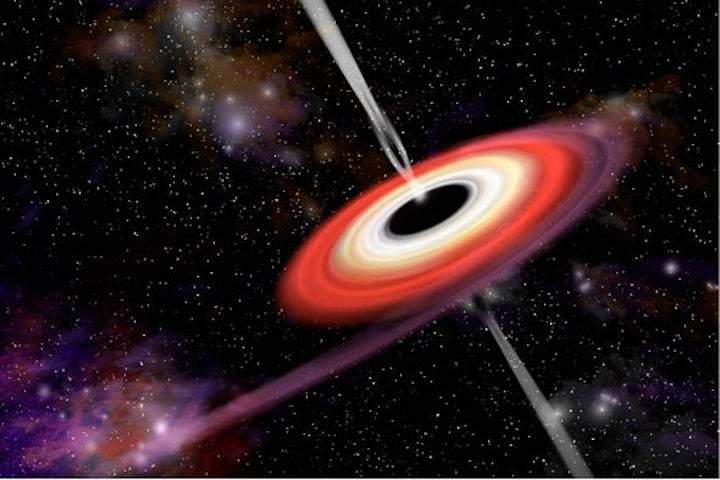25.08.2021
Recent work has shown how “naked singularities” might defy the cosmic censorship conjecture

Black holes are often described as dangerous destructive entities that never give up what falls into their grasp. But what if black holes areprotective—shielding us from the unpredictable effects of places where our physical understanding of the universe breaks down? This question might sound flippant, but in fact, it is at the heart of a decades-long physics puzzle known as “cosmic censorship,” one that researchers may finally be close to answering.
Inside black holes, physics as we know it ends. Our current theory of gravity, Einstein’s general theory of relativity, predicts its own failure at points in spacetime called “singularities.” According to the equations, at these points, gravitational fields behave unpredictably, often intensifying to impossibly, infinitely high levels where the equations themselves cannot describe what happens.
The foundational tenets of physics demand that the real, physical world continues to make sense inside black holes. They tend to interpret this breakdown of the math to mean that some as yet unknown physics, which likely involves quantum mechanics, takes over near the singularities. But until they have found a theory that unifies gravity and quantum physics, exactly what happens at those points cannot be known.
Thankfully, with the singularities tucked inside the black holes, we do not have to worry about their potentially bizarre effects on the external world. But what if these singularities could show up outside—on their own? The implications could be huge. Because we do not yet have a complete theory to describe what happens in singularities, we cannot trust the story that general relativity tells us. “Naked singularities cause general relativity to lose its predictive power,” says Yen Chin Ong, a physicist at Yangzhou University in China, who has studied the nature of singularities in gravitational theories.
During the 1960s, British physicist Roger Penrose was in the midst of work on the mathematics of black holes and singularities that would later earn him the 2020 Nobel Prize in Physics. At that time, no one had turned up any compelling evidence that the equations of general relativity could describe these uncovered singularities in a physically sensible universe. They only ever materialized cloaked inside a black hole. Penrose pieced together clues that suggested a conjecture—an informed guess, not an airtight proof—that general relativity would never make that prediction. This conjecture is known as cosmic censorship: somehow the math must work out so that nature censors those “naked” singularities from existence.
Cosmic censorship is an idea that sounds to physicists like it must be right, and most assume it is. Although researchers have suggested ways to spot naked singularities—observable signs that could distinguish them from black holes—astronomers have not yet seen any evidence of them. Nevertheless, after more than 50 years, no one has proved or disproved Penrose’s conjecture.
In the first few decades after Penrose’s initial work, theoretical studies supported the idea that cosmic censorship would hold. Then, in 2010, physicists Luis Lehner and Frans Pretorius used a computer simulation to show that the outer surface of black holes could break into pieces and leave behind naked singularities. The fracturing comes with a curious twist, though. It happens through a process, the so-called Gregory-Laflamme instability, that can only happen in universes with more than three dimensions of space. In other words, these sorts of singularity-revealing instabilities should be impossible in our universe’s three dimensions as described by general relativity.
Despite this caveat, the result still has meaning. With this one example as a starting point, researchers can look for similar processes and ask, “Does something like that happen in our universe?” If the answer is no, they can ask, “Why not?” Pau Figueras, a physicist at Queen Mary University of London, says that this approach does not equate to a full proof but that it is still persuasive. “If this particular process is the only way to violate cosmic censorship,” he says, “and astrophysical black holes do not suffer from it, then this offers a way to prove that [Penrose’s] conjecture is true in astrophysical spacetimes.”
Lehner and Pretorius’s result inspired a new burst of interest in cosmic censorship. According to Figueras, the field has gained momentum in the past decade, thanks largely to advances in computing that have made it possible to calculate how black holes evolve and, in some cases, fall apart to reveal singularities. “It’s not only that the computers needed weren’t available 20 years ago,” he says. “We didn’t understand how to simulate general relativity and hence black holes in computers.” The result, he says, is that yes, naked singularities are more common than expected—in universes with extra dimensions.
Figueras and his colleagues have demonstrated, for instance, that naked singularities can show up when black holes collide. Such collisions happen even in our university. But the researchers found that such events in our universe do not produce the same result—a collision always ends with the singularity still wrapped inside a black hole.
A full proof or conclusive refutation of Penrose’s cosmic censorship conjecture remains elusive. Whether or not the conjecture holds, though, the puzzle itself is no longer the main point for most theorists, Ong says. “It is what we can learn along the way, what insights we can gain, what tools we can develop,” he adds. “The journey will be important, not just the destination.”
Quelle: SCIENTIFIC AMERICAN

